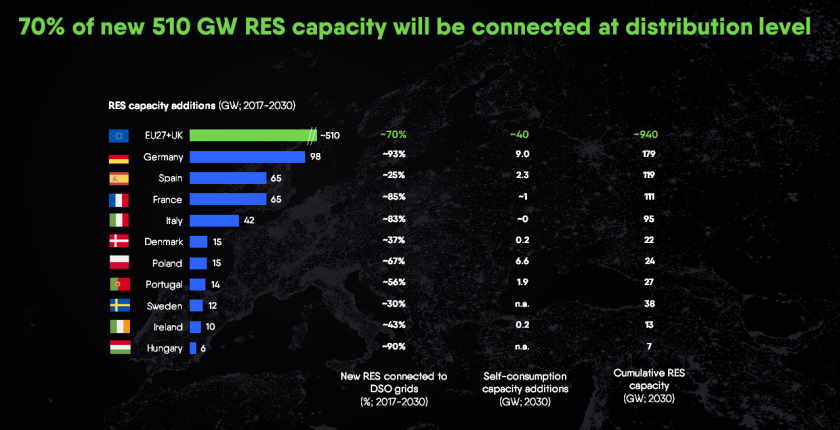
Photo: Eurelectric/E.DSO
European distribution grids will need investments of EUR 375-425 billion through 2030 to be fit-for-purpose in an increasingly decarbonized, decentralized, and digitalized power system. These grids are a base for electrification and capacity expansion, a connecting point for renewables, and an enabler for demand management and customer participation in the energy transition.
There is an urgent need to ramp up investments in Europe’s distribution grids by 50-70% in the 2020s compared to the previous decade, according to a landmark study conducted by industry bodies Eurelectric and E.DSO. A first of its kind, the study was carried out by Monitor Deloitte on the basis of detailed empirical data from 10 European countries.
The average annual investment needs are EUR 34-39 billion, which represents a 50-70% increase on the amount spent in 2019, the study reads.
The EU and the UK will install about 510 GW of new renewable capacity by 2030. About 70%, or 360 MW, will be connected to the distribution grid, while 40 GW will be for self-consumption.

The study, titled Connecting the dots: Distribution grid investment to power the energy transition, was conducted by the analytical support and facilitation of Monitor Deloitte. The scenario-based analysis assumes:
- 510 GW of new renewable capacity would be installed at the EU27+UK level. Of those, over 470 GW will be represented by centralized solar and wind capacities, whereas 40 GW will be represented by self-consumption. The total cumulative capacity by 2030 is approximately 940 GW.
- The cumulated annual growth rate of electricity demand is 1.8% in EU27+UK. Industrial and power-to-X demand would reach ~3,530TWh by 2030, while 50-70 million f electric vehicles (EVs) (20-25% of the passenger car fleet) and 40-50 million heat pumps will increase the electricity demand from the transportation and buildings sectors.
Key investment drivers: Renewables, electrification and old age

A significant part of the investment needs is driven by the ongoing energy transition: expansions and replacements related to the integration of variable renewables such as solar and wind, 70% of which will be connected at the distribution level, as well as to the progressive electrification of industry, transportation and buildings, according to the study.
The single biggest investment driver, however, is the modernization of the infrastructure because approximately one third of the EU’s grids are already over 40 years old.
Limited price impact and societal benefits

Despite the average annual investment needs of EUR 34-39 billion, the impact on electricity prices and grid tariffs is likely to be moderate if policy makers and regulators provide the right framework conditions and a smart tariff design.
Moreover, the societal benefits in relation to sustainability, economy, and competitiveness, brought about by this transformation, will outweigh the economic impacts: The EU could save over EUR 175 billion in fossil fuel imports annually, and ultimately reduce the average electricity costs by EUR 28-37 billion in the long term, according to the study.
Ruby: Policymakers to improve investment frameworks
Kristian Ruby, Secretary General of Eurelectric, said that grid investments are urgently needed for the energy transition.
“We call on policymakers to improve investment frameworks and tariff design, facilitate access to EU funds and accelerate authorization and permit granting processes,” he added.
Christian Buchel, Chairman of E.DSO, and Director for Territories, Customers and Europe at Enedis, said that decision makers, political bodies, citizens, regulators, financial institutions, and NGOs need to understand how essential it is to reach the requested high level of quality investments.









Be the first one to comment on this article.